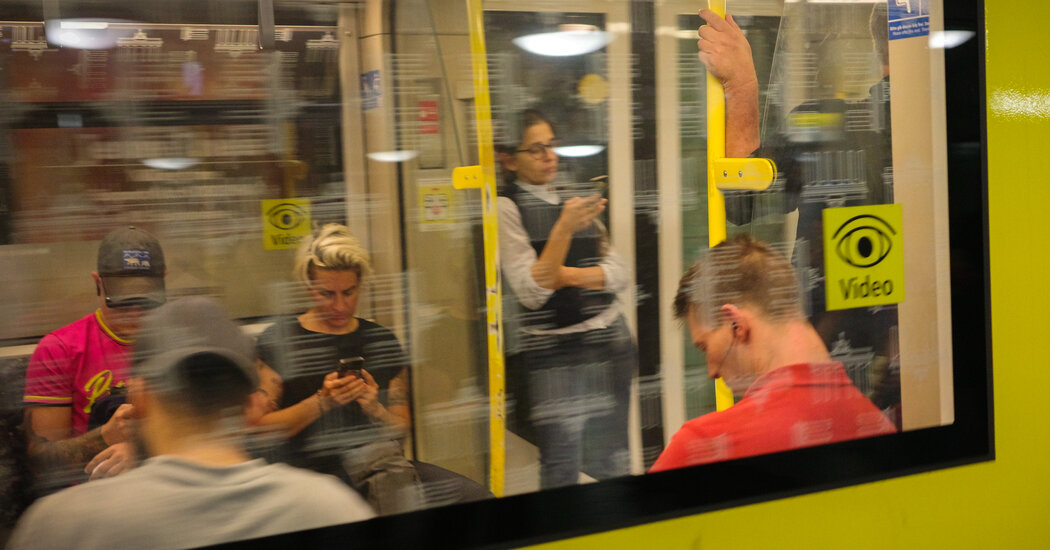DEAD AND ALIVE: Essays, by Zadie Smith
“Today, everything exists to end in a photograph,” Susan Sontag wrote in 1977, updating Stéphane Mallarmé’s 19th-century claim that everything in the world exists to end up in a book. In every era, our reality has been shaped and valued by the technologies through which it’s documented and shared. But now, when everything exists to end in a social media feed or generative A.I. model, it’s clear that not all eras or technologies are alike.
“It’s the double theft that gets me,” writes Zadie Smith of our digitally umpired world in “Some Notes on Mediated Time,” one of the standout essays in her latest collection of nonfiction, “Dead and Alive.” “The way it makes the public private, and the private public.” A train compartment filled with passengers gazing into their phones is the essay’s resonant image: a silent tableau that represents a vanishing public commons, the kind in which the sharing of experiences and the exchange of ideas were unmediated by algorithms that silo us into demographics while preying upon our insecurities.
Filled with Smith’s crisp observations, “Dead and Alive” is a smart, somber book informed by a sharp right turn in politics and a great deal of anxiety about how we look at and talk about art (and, by proxy, reality). In a review of Todd Field’s 2022 film “Tár,” Smith describes a scene in which a Juilliard student confesses to being “not really into Bach” to the formidable Lydia Tár, a conductor and “Cultural Luminary,” as Smith describes her.
“Honestly,” the student, Max, explains, “as a BIPOC pangender person, I would say Bach’s misogynistic life makes it kind of impossible for me to take his music seriously.” Tár proceeds to humiliate Max, oblivious to the reversals to come, and the scene turns into a small parable of clashing generations by which Smith indicts her own (X), along with everyone else.
“Speaking for myself,” Smith writes, “I’m the one severely triggered by statements like ‘Chaucer is misogynistic’ or ‘Virginia Woolf was a racist.’ Not because I can’t see that both statements are partially true, but because I am of that generation whose only real shibboleth was: ‘Is it interesting?’”
These things can be very interesting when Smith wades into the fray, insofar as they suggest other ways of thinking about art and its place in a world where we might wish to live. In essays on older and younger artists alike, she traces the blind spots and revelations that accompany cultural change. In a piercing look at the memoirist and painter Celia Paul, whose relationship with Lucian Freud began when Paul was an 18-year-old art student at the Slade School of Fine Art and he was a 55-year-old Cultural Luminary, Smith writes, “Misogyny, whatever else it might be, is a form of distortion, a way of not seeing, of assuming both too much and too little.”
That distortion affected Freud’s portraits of women: Though celebrated for his forensic scrutiny, he missed the essence of Paul — her creative ambition — in his meekly feminine portraits of her. After their decade-long relationship ended, he painted her at her easel in a harshly petty caricature. “Freud painted the visible: flesh, breasts, eggs,” Smith concludes. “Paul’s work is a visionary account of ineffable qualities, like love, faith, silence, empathy.”
Criticism presupposes the existence of a commons in which such insights and reconsiderations matter, and where discussions of art’s attunements, from Kara Walker’s “mode of relating to the ruins of the past” to Toyin Ojih Odutola’s paintings inspired by alternative flows of power in African lore, can shift the cultural focus or even revise notions of progress. “We know we don’t want to be victims of history,” Smith reflects. “We know we refuse to be slaves. But do we want to be masters — to behave like masters?”
Rarely do her analyses surprise me, but there’s pleasure in watching a novelist wired to see all sides at once wrangle with her own dynamic subjectivity; what’s compelling is the effort of eliciting in herself the most honest possible take. As in her previous essay collections, some of the best moments in “Dead and Alive” are found in her more personal and elegiac writings: memories of not-quite-shed teenage selves or generous tributes to an older generation of writers — including Toni Morrison, Hilary Mantel and Joan Didion, from whom Smith, as a young writer, once bummed a cigarette at a party, unaware of who she was.
Smith’s affectionate portraits of New York and northwest London suggest that some form of commons remains intact, ready to offer ad hoc assistance when a stroller breaks down or an elderly woman stumbles. Part of the comic beauty of these urban scenes is the wordlessness with which passers-by swiftly come together to assist and then disperse: solidarity without speech.
The contrast to the raucous, algorithmically manipulated digital communities she describes in “The Dream of the Raised Arm” is profound. Discussing “The Third Reich of Dreams,” a diary of the subconscious that the journalist Charlotte Beradt kept during Hitler’s rise to power, Smith considers how totalitarian impulses are assimilated and enacted in our own time.
It won’t be news to anyone living in 21st-century America that language can be “euphemized, instrumentalized and abused — put to work for your cause and only for your cause, so that it does exactly and only what you want it to do,” as Smith warns in “Shibboleth.” A convoluted critique she wrote in the early months of campus protests demanding divestment from Israel, the essay seems to equate the rhetoric of peaceful student activists with that of government officials justifying the assault on Gazans. “It is my view that my personal views have no more weight than an ear of corn in this particular essay,” Smith concludes, an odd swerve for a famous author in a discussion about the ethics of rhetoric in the face of ongoing slaughter.
Writing criticism — offering an opinion, putting one’s skin in the game — is a form of stewardship to the commons, of showing up to that imperiled space in which Cultural Luminaries might decide to join students in speaking out against injustice, however imperfectly, because they feel an ethical imperative to do so: solidarity with speech. In “Dead and Alive,” Smith reminds us that this place still exists, even as its lights flicker and dim.
DEAD AND ALIVE: Essays | By Zadie Smith | Farrar, Straus & Giroux | 335 pp. | $30
The post Zadie Smith Considers Art in the Age of Relentless Progress appeared first on New York Times.




